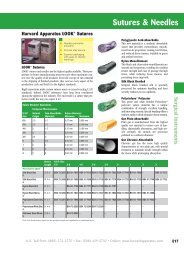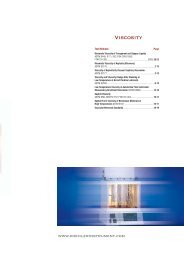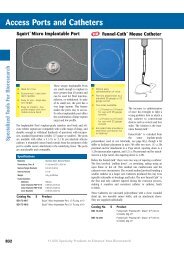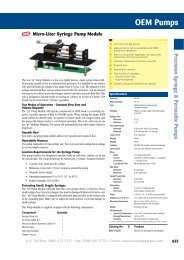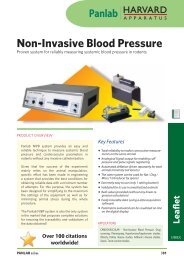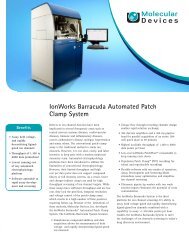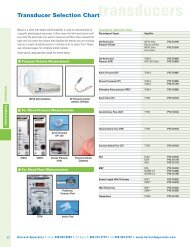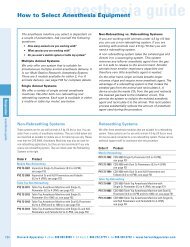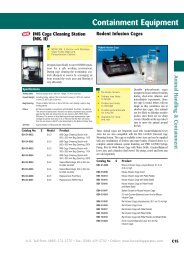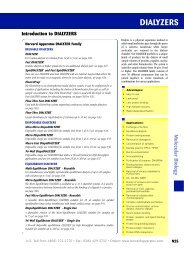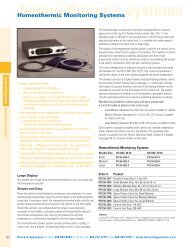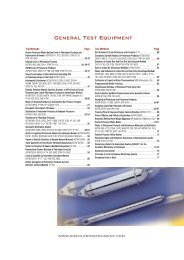Oocyte Clamps Electrophysiology Oocyte Clamp OC-725C
Oocyte Clamps Electrophysiology Oocyte Clamp OC-725C
Oocyte Clamps Electrophysiology Oocyte Clamp OC-725C
You also want an ePaper? Increase the reach of your titles
YUMPU automatically turns print PDFs into web optimized ePapers that Google loves.
<strong>Oocyte</strong> <strong><strong>Clamp</strong>s</strong>NEW<strong>Oocyte</strong> <strong>Clamp</strong> <strong>OC</strong>-<strong>725C</strong>Specialized Tools For BioresearchThe <strong>OC</strong>-<strong>725C</strong> <strong>Oocyte</strong> <strong>Clamp</strong> is designed for two-electrode, whole-cellvoltage clamping of Xenopus oocytes. The dedicated design of the <strong>OC</strong>-<strong>725C</strong> includes such features as high compliance voltage (±180 V) andunique bath clamp circuitry. These same features also make the <strong>OC</strong>-<strong>725C</strong>ideal for clamping other large cells and cell structures such as squidaxons. Improvements to this version include an extended current measuringrange, decreased noise level and a 4-pole Bessel filter.Fast Stable Voltage <strong>Clamp</strong>ingThe <strong>OC</strong>-<strong>725C</strong> combines high AC and DC gains and a voltage complianceof ±180 volts to insure fast, nonsaturating clamp performanceunder nearly any condition. The AC clamp gain is variable up to2000. An additional DC gain of 1 x 10 6 may be employed for highconductance cells (leaky oocytes).Two clamp speeds are available: The Slow mode is used for screeningoocytes or for applications not requiring fast response times. The Fastmode is used for accurate voltage clamp of fast whole cell currents.<strong>Clamp</strong> response time in the Fast mode is 350 μsec (10-90% rise time)when applying a 100 mV step to a model cell, see specifications onfacing page.Improved Bath <strong>Clamp</strong> HeadstageThe current measuring range of the <strong>OC</strong>-<strong>725C</strong> bath clamp headstagehas been extended at both ends by the addition of a 3 position rangemultiplier. Smaller currents are amplified to usable levels and largercurrents up to 1 mA can be recorded without output saturation. Theunique design of the bath clamp eliminates the need for series resistancecompensation. It provides an accurate measurement of bathcurrent by creating a virtual ground in the bath while simultaneouslyclamping the bath potential at zero.Voltage Headstage ProbeThe voltage measuring headstage is a single-ended, high-impedanceprobe. Its small size, convenient mounting rod and 2 meter cable makefor easy attachment to a micropositioner. The headstage input is a 2 mmdiameter pin. An electrode holder with a 2 mm jack (supplied) mountsdirectly on the headstage.Voltage & Current MetersIndependent meters provide simultaneous displays of membranevoltage V mand membrane current I m. To assure proper impalementof the current electrode, the current meter displays membranepotential V efrom the current electrode before the clamp circuit isturned on.<strong>Clamp</strong> CommandsThe internal Hold control is a digital push button control with tworanges; ±1 to 99 mV (x1) and ±2 to 198 mV (x2). Hold can beincremented in steps of 1, 2, 10 and 20 mV for I-V studies. Externalcommand signals applied to Command IN ÷10 are attenuated toreduce noise from the command source. Hold and external commandsare summed.Additional Features• Buzz controls (1 kHz square wave) for each electrode aid inpenetration of cell membranes with a minimum of leakage.• Overload alarm (audible and visual) indicate when the compliancevoltage is exceeded safeguarding the oocyte andindicating that current records are subject to saturation.• DC Offsets for both voltage and current electrodes.• Electrode Test for both electrodes.• Capacity Compensation for the Vm voltage input.Electrode HoldersTwo vented electrode holders with silver wires are typically requiredwith the clamp; a straight type for use with the voltage headstage anda 45° type with mounting handle for use with current electrodes.Vents have been added to the electrodes to prevent pressure buildupinside the electrode which can damage oocytes.These holders are available separately. Select the holder based onyour glass outer diameter. Unvented holders are available and have a“N” at the end of the model number. Vented holders have a “V” onthe end of the model number. A two meter length cable assembly isprovided to connect the current electrode holder to the clamp.H2011,000 Specialty Products to Enhance Your Bioresearch
<strong>Oocyte</strong> <strong><strong>Clamp</strong>s</strong>NEWRC-1Z <strong>Oocyte</strong> Recording ChamberRC-1Z ChamberModel RC-1Z is a simple, low cost perfusionchamber for oocyte studies. It features aslot shaped bath for applications requiringrapid perfusion.To aid in holding the oocyte in position, thechamber bottom has three dimples withdiameters of 0.8, 0.9, and 1.0 mm. Threeslots milled into the chamber bottom perpendicularto the direction of solution flowaid in bathing the bottom side of theoocyte.The perfusion input accepts standard1/16in. OD (PE-160) polyethylene tubing.Solutions are removed from the suctionwell via an adjustable suction tube.Solution height is adjusted by raising orlowering the suction tube.An agar bridge well with connecting channelto the input side of the bath is providedfor making bridge connections to the bath.Specialized Tools For BioresearchSpecificationsMaterialPolycarbonateFootprint, L x W7.7 x 5.1 cmBath Dimensions, L x W x H 25 x 3.5 x 2.5 mmVolumeApprox. 85 μl/mm HeightChamber Floor Insert 25 x 75 x 3 mm polycarbonateInput Tubing Size, OD 1/16 in (PE-160)Output Tubing Size, ID 1/16 inCatalog No. $ Model ProductBS4 64-0318 263.00 RC-1Z <strong>Oocyte</strong> ChamberOptional AccessoriesBS4 64-0755 13.00 PE-160/10 Polyethylene Tubing,1/16 in OD x 10 ftBS4 64-0206 67.00 MP-2 Perfusion Manifold, 2 InputsBS4 64-0207 67.00 MP-3 Perfusion Manifold, 3 InputsBS4 64-0208 67.00 MP-4 Perfusion Manifold, 4 InputsBS4 64-0209 78.00 MP-5 Perfusion Manifold, 5 InputsBS4 64-0210 78.00 MP-6 Perfusion Manifold, 6 InputsBS4 64-0211 89.00 MP-8 Perfusion Manifold, 8 InputsFor <strong>Oocyte</strong> <strong>Clamp</strong> <strong>OC</strong>-<strong>725C</strong>,see pages H20 - H21.For Complete <strong>Oocyte</strong> Two-Electrode Voltage<strong>Clamp</strong> Workstation, see page H26.For HAI 118 Data Acquisition System for<strong>Oocyte</strong> <strong>Clamp</strong>ing, see pages H24 - H25.H2211,000 Specialty Products to Enhance Your Bioresearch
<strong>Oocyte</strong> <strong><strong>Clamp</strong>s</strong>NEWRC-3Z <strong>Oocyte</strong> ChamberRC-3Z Chamber shown with the Warner<strong>OC</strong>-725 Bath <strong>Clamp</strong> HeadstageModel RC-3Z is a simple low-cost chamber for studies of oocytes andother large cell structures. It features two slot-shaped bath wells – anarrow well for applications requiring rapid perfusion exchange anda wider well which permits good electrode access. Solution height isadjustable by raising or lowering the suction tube. Two isolated wellsare provided for making agar bridge connections from the headstageto the bath. The perfusion inputs accept standard 1/16 inch OD(PE-160) polyethylene tubing. The suction tube connects to1/16 inch ID tubing. Threaded holes are included for the attachmentof a Warner oocyte clamp bath headstage.SpecificationsMaterialPolycarbonateFootprint, L x W13 x 7.7 cm (5.1 x 3 in)Bath Dimensions:Narrow Bath, L x W x H 27 x 3.2 x 3.2 mm; Approx. Volume: 85 μl/mm HeightWide Bath, L x W x H 27 x 6.3 x 3.2 mm; Approx. Volume: 170 μl/mm HeightChamber Floor Insert 25 x 75 x 1 mm PolycarbonateInput Tubing Size1/16 in OD (PE-160)Output Tubing Size 1/16 in IDCatalog No. $ Model ProductBS4 64-0319 293.00 RC-3Z <strong>Oocyte</strong> ChamberOptional AccessoriesBS4 64-0755 13.00 PE-160/10 Polyethylene Tubing 1/16 inOD x 10 ftBS4 64-0206 67.00 MP-2 Perfusion Manifold, 2 InputsBS4 64-0207 67.00 MP-3 Perfusion Manifold, 3 InputsBS4 64-0208 67.00 MP-4 Perfusion Manifold, 4 InputsBS4 64-0209 78.00 MP-5 Perfusion Manifold, 5 InputsBS4 64-0210 78.00 MP-6 Perfusion Manifold, 6 InputsBS4 64-0211 89.00 MP-8 Perfusion Manifold, 8 Inputs<strong>Electrophysiology</strong>For <strong>OC</strong>-<strong>725C</strong> <strong>Oocyte</strong> <strong>Clamp</strong>,see pages H20 - H21.U.S. Toll Free: (800) 272-2775 • Fax: (508) 429-5732 • Online: www.harvardapparatus.comH23
<strong>Oocyte</strong> <strong><strong>Clamp</strong>s</strong>NEWHAI 118 Data Acquisition SystemBS4 69-3130 HAI 118 Data Acquisition SystemUSB connectionConnection to the computer is accomplished over the popular USBport. This eliminates the need to install special interface cards andeven makes the HAI 118 compatible with notebook computers. TheHAI 118 has a small footprint and in combination with a notebookrequires very little bench space.Software includedPowerful LabScribe ® software is included with each HAI 118.Described below, LabScribe is provided with a site license at no additionalcharge and upgrades are free forever. The program will actuallyupgrade itself on any Internet connected machine.Specialized Tools For Bioresearch• 100KHz 16 bit A/Dconverter• Easy to install USBconnection• Built-in stimulator anddigital outputs• Low noise• Full gain telegraph supportfor Warner Instrumentsclamp amplifiersThe HAI 118 is a fast high-resolutiondata acquisition systemsuitable for most data recordingstudies in the research laboratory.It offers 8 analog input channels,8 digital outputs, 4 digitalinputs and 2 DACs. TheHardware connects to PC compatiblecomputers via the popularUSB interface, so setup isplug-and-play easy.Hardware Features:DACThe HAI 118 offers two ±10V DACs. Each DAC is independently programmableand can be synchronized with one another. Basic stimulusparameters for each DAC, such as pulse width, frequency andamplitude can be changed on the fly using handy controls located inthe LabScribe ® software tool bar. Standard protocols include pulse,train, and step waveform. Each standard protocol allows the quiescentstate to be a holding voltage thereby making it ideal for voltageclamping applications.Resolution and NoiseThe HAI 118 employs a 16 bit A/D converter to sample data over its±10 Volt input range. Typical noise on any input is less than 1 millivolt.This allows the recording of signals from 10 mV to 10V withoutthe need for additional external gain.Digital Input/Output8 digital output lines are available. The digital output connectors areindustry standard BNC, eliminating the need for custom cables.Programming the output lines is point-and-click easy as well - nocomplicated scripting language is required. Four digital input linesare also provided, with one configured as an external trigger.SpeedThe HAI 118 is a fast recorder. At top speed it can collect 100,000,16 bit samples per second on a single channel. With 8 channelsenabled it can collect data at 10,000 samples per second on each ofthe open channels.Software Features:Real unitsLabScribe software allows you to Calibrate the displayed data in anyunits that you choose. Reading your data in mmHg, grams or microamps is a snap.Display controlsLabScribe uses an AutoScale feature that automatically ensures theoptimal scaling of displayed data. A simple click centers and expandsthe data in the display window to fill the available space. Time baseor y axis scaling can be zoomed in or out with a single click.Realtime NotationsKeyboard input from the user may be time locked to the data to indicatedrug delivery or stimulus points. Annotations can be positionedin the data much as you would write on chart paper.Thirteen Realtime FunctionsLabScribe currently supports 13 functions that are calculated anddisplayed in realtime, each called from a single click in the mainwindow. These include Rate, Frequency, Period, Max, Min, Mean,Integral, dV/dt and Filter. Functions can be applied to raw data inreal time or they can be called after the data has been recorded. Nomatter how data may be permuted, raw data is always preserved.Twenty-Six Off Line CalculationsTwenty-Six off line calculations are also supported. These operate ona selection of data and return a value. While more are being added,the current list includes Area Under the Curve, Max-Min, Slope at aPoint, Slope of the Line of Best Fit and the mean.Data Exported to .txt or .png FilesAny view of the data can be exported to the disk as a text file or agraphic. This is ideal for post calculation in programs like Excel orMACLAB. Picture formats make reports or poster presentations easy.Of course you can always print data from any window in theprogram.Gain TelegraphLabScribe will automatically calibrate and display the output ofWarner Instrument Voltage/Patch clamp amplifiers. This featuretakes into account the changes in gain that may be applied from thevoltage clamp.Fast ScrollingLabScribe display can smoothly scroll data at any speed. This is particularlyuseful when high resolution data is compressed on the timeaxis to create a data overview.H2411,000 Specialty Products to Enhance Your Bioresearch
<strong>Oocyte</strong> <strong><strong>Clamp</strong>s</strong>NEWHAI 118 Data Acquisition SystemSettingsSettings or templates for various experiments are stored in the programssettings menu. This makes changing program settings toaccommodate different experiments point-and- click easy.Applications Supported:<strong>Oocyte</strong> clampLabScribe’s gain telegraph feature automatically calibrates the softwareto any Warner Instruments <strong>Oocyte</strong> <strong>Clamp</strong> so that the main displayreads in current and voltage. The on board stimulator includesa flexible voltage clamp protocol so an external stimulator is notrequired. Finally, the digital output capability of the HAI 118 alsoadds the ability to automate your <strong>Oocyte</strong> rig.Epithelial <strong>Clamp</strong>Output from Warner Instruments or other epithelial voltage clampscan be fed directly into the HAI 118. The voltage clamp protocol inthe LabScribe program’s stimulator section makes recordings of fourto six channels of epithelial data possible.Blood Flow and Blood pressureBlood flow data from doppler devices and blood pressure signalsfrom available transducer amplifiers can be fed directly into the HAI118. Analytical features in the LabScribe software can give beat-tobeatrate, systolic, diastolic and mean pressures, as well as dP/dt.Hemodynamic StudiesBlood pressure signals from available transducer amplifiers can befed directly into the HAI 118. Analytical features in the LabScribesoftware can display beat-to-beat rate, systolic, diastolic and meanpressures as well as dP/dt. Up to 8 channels of pressure data can berecorded and the high speed nature of the hardware makes it idealfor use with rapid heart rate animals such as mice.<strong>Electrophysiology</strong>.The high speed nature of the HAI 118 make it perfect for studiesinvolving blood pressure and sympathetic nerve activity as well as alltypes of cardiac electrophysiology, even in rapid heart rate animalssuch as mice where extra speed is required.SpecificationsInput:Number of Inputs8 single ended BNCInput Impedance1 MInput Range±10 VNoise1 mV typicalGain TelegraphSoftware or hardware 8 bitOutput:Number of DACs 2DAC Resolution12 bitDAC Speed100 k s/sec independent of sample speedDAC Output Range ±10 VDigital Output Lines 8 TTLDigital Output Connector BNCA/D Converter:Sample Speed1 S/sec-100 k S/secResolution16 bitInterfaceUSBTrigger/Digital Input Lines 4, TTLEnclosureAluminumPower120/220 VAC, 60/50 Hz, CE compliantTrigger ModesDisplayDAC ModesDAC Performance:Pulse WidthFrequencyCatalog No. $ ProductExternal trigger, Threshold trigger from data,User triggerReal time, User definable screen time independentof sample rate. User definable units, AutoScale,Full Scale or User defined scalePulse, Train, Step, DC, Custom0.01 msec to 6500 msec (Pulse mode)0.2 Hz to 50 kHz (Pulse Mode)BS4 69-3130 4,155.00 HAI 118 Data Acquisition System<strong>Electrophysiology</strong>For Microscopes, see pages M149 - M150.For Micro-Incubators, see pages M80 - M97.For Microinjectors, see pages M70 - M77.For Micromanipulators, see pages M186 - M201.For <strong>OC</strong>-<strong>725C</strong> <strong>Oocyte</strong> <strong>Clamp</strong>,see pages H20 - H21.For <strong>Oocyte</strong> Recording Chambers,see pages H22 - H23.For a Complete <strong>Oocyte</strong> Two-ElectrodeVoltage <strong>Clamp</strong> Workstation, see page H26.U.S. Toll Free: (800) 272-2775 • Fax: (508) 429-5732 • Online: www.harvardapparatus.comH25
<strong>Oocyte</strong> <strong><strong>Clamp</strong>s</strong>NEW<strong>Oocyte</strong> Two-Electrode Voltage <strong>Clamp</strong> Workstation TEV700BS4 64-0034 TEV700 <strong>Oocyte</strong> Two-Electrode Voltage <strong>Clamp</strong> Work StationSpecialized Tools For Bioresearch• <strong>Oocyte</strong> <strong>Clamp</strong> <strong>OC</strong>-<strong>725C</strong>,see pages H20 - H21• RC-3Z <strong>Oocyte</strong> Chamber,see page H23• MM-33L Manipulator,see page M190• MM-33R Manipulator,see page M190• MB/B Magnetic Base,see page M201The TEV700 Workstation provides many of the necessary components typically used with the <strong>OC</strong>-<strong>725C</strong> voltageclamp. When these components are purchased with the <strong>OC</strong>-725 <strong>Oocyte</strong> <strong>Clamp</strong>, the complete package isdiscounted as shown. The individual components of the system are listed below.Catalog No. $ Model ProductBS4 64-0034 6,125.00 TEV700 Complete <strong>Oocyte</strong> Two-Electrode Voltage <strong>Clamp</strong> Work StationSystem ComponentsBS4 64-0028 4,615.00 <strong>OC</strong>-<strong>725C</strong> <strong>Oocyte</strong> <strong>Clamp</strong>BS4 64-0319 293.00 RC-3Z <strong>Oocyte</strong> ChamberBS4 64-0055 765.00 MM-33L Left ManipulatorBS4 64-0056 765.00 MM-33R Right ManipulatorBS4 64-0060 53.00 MB/B Magnetic Base, must purchase 2 for complete systemFor Glass Capillaries, see pages M45 - M50.For Pipette Pullers, see pages M51 - M54.For HAI 118 Data Acquisition System for<strong>Oocyte</strong> <strong>Clamp</strong>ing, see pages H24 - H25.For <strong>Oocyte</strong> Injection, see the PLI-100and PLI-90 on pages M72 - M74.H2611,000 Specialty Products to Enhance Your Bioresearch
Intracellular/Extracellular AmplifiersNEWIntracellular Electrometer IE-251AOverdrive IndicatorsTwo visual indicators call attention to overload conditions:• Input Overdrive is illuminated whenever the probe inputvoltage exceeds ±1 V, caused by either excessive currentthrough the microelectrode or an open circuit (open orblocked electrode).• Current Overdrive warns of excessive voltage (>50 V)applied to the Stimulus Input.This Intracellular Electrometer is supplied with a probe. AnElectrode Holder must be purchased separately based on your glassouter diameter. Also, specify line operating voltage if other than100-130 VAC.The IE-251A is a moderately priced intracellular electrometer, completewith current passing capability, incorporating the same basicdesign as the more costly IE-210. The important features requiredfor low noise, drift free recording from glass microelectrodes havebeen retained in this lower cost model. The IE-251A is easy to useand an excellent choice for the budget-conscious researcher or studentteaching lab.The IE-251A features a very small active headstage, essentially thesame as used with the more costly IE-210. Epoxy-sealed constructionaffords maximum resistance to saline corrosion. Its small size andlow mass permit easy mounting in a micro-positioner. The electrodeholder supplied connects directly to the probe input.The amplifier features include:• Fixed gains are at x1 and x10.• Capacity Compensation neutralizes input capacitance upto 50 pF.• Junction potentials up to ±200 millivolts are nulled withthe DC Position control.• Electrode Test provides convenient electroderesistance check.• Push button operated Buzz produces oscillations at pipettetip to facilitate cell impalement.• Convenient Probe Test port permits fast check of amplifierperformance.Current InjectionThe injection circuitry of the IE-251A allows simultaneousstimulation and recording through microelectrode resistances up to1000 megohms in two ranges. Voltages at the Stimulus Input areconverted to constant currents applied to the electrode. The steadystate and transient components of the current injection artifact arenulled with the DC and transient balance controls. The correctedsignal is viewed at the single-ended bridge output. Electroderesistance is read from the DC balance ten-turn dial.For Glass Capillaries, see pages M45 - M50.For Pipette Pullers, see pages M51 - M54.SpecificationsAmplifier:Input Impedance >10 11 shunted by 0.5 pFNoise Level(0.1 Hz to 10 kHz)*25 μV p-p input shorted250 μV p-p, 20 M at inputOutput Resistance 100 Gainsx1 & x10Rise Time (10 to 90%) 10 μsec measured with 20 M resistorCapacity Compensation 0 to 50 pFProbe Input Voltage Range ±1 VDC Positioning Range ±200 mV referred to inputLeakage Current Adjustable to zeroElectrode Test1 mV/MBuzz:Amplitude variable 0-15 VFrequency variable 100 Hz to 10 kHzCurrent Injection:Bridge Balance Ranges 0 to 100 M and 0 to 1000 MCurrent Injection Limit ±1 V divided by electrode R or 0.5 μA, whichever occurs firstStimulus Input Resistance 3.3 kMaximum Stimulus Input ±50 VBridge Bal. Output Resist. 100 I Monitor Output Resist. 1 kI Monitor Output Scale Factor 1V = 50 nAPower Requirements 100 to 130 or 220 to 240 V, 50/60 Hz, 10 VAPhysical Dimensions:Case Size 12.5 x 20.3 x 25.4 cm (H x W x D)Probe9.5 mm x 6.5 cm (D x L) with 1.8 m L cableProbe Handle 6.5 mm x 6.5 cm (D x L)Shipping Weight4.5 kgWarrantyTwo years, parts & labor* At x1 output.Catalog No. $ Model ProductBS4 64-0090 1,448.00 IE-251A Intracellular ElectrometerElectrode Holders for IE-210/251ABS4 64-0964 47.00 ESP/W-F10N Electrode Holder, Straight 1.0mm forIE-210/251ABS4 64-0965 47.00 ESP/W-F12N Electrode Holder, Straight 1.2mm forIE-210/251ABS4 64-0966 47.00 ESP/W-F15N Electrode Holder, Straight 1.5mm forIE-210/251ABS4 64-0967 47.00 ESP/W-F20N Electrode Holder, Straight 2.0mm forIE-210/251AOptional AccessoriesBS4 64-0043 348.00 2510 Replacement Headstage<strong>Electrophysiology</strong>U.S. Toll Free: (800) 272-2775 • Fax: (508) 429-5732 • Online: www.harvardapparatus.comH27



